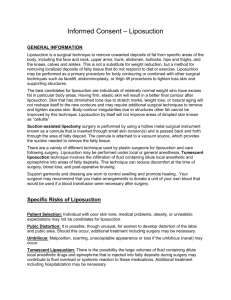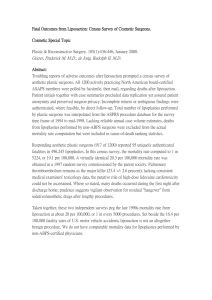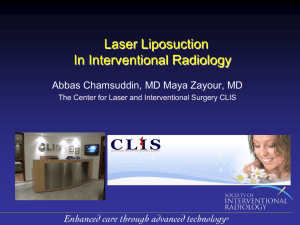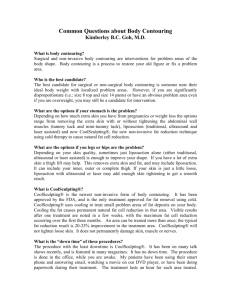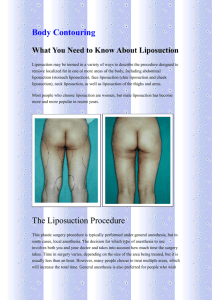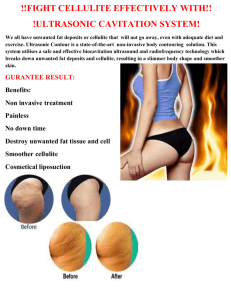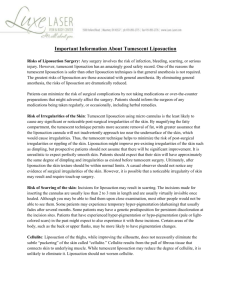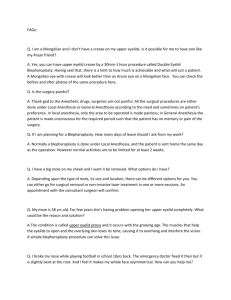Martin K - Institute of Aesthetic Plastic and Reconstructive Surgery
advertisement
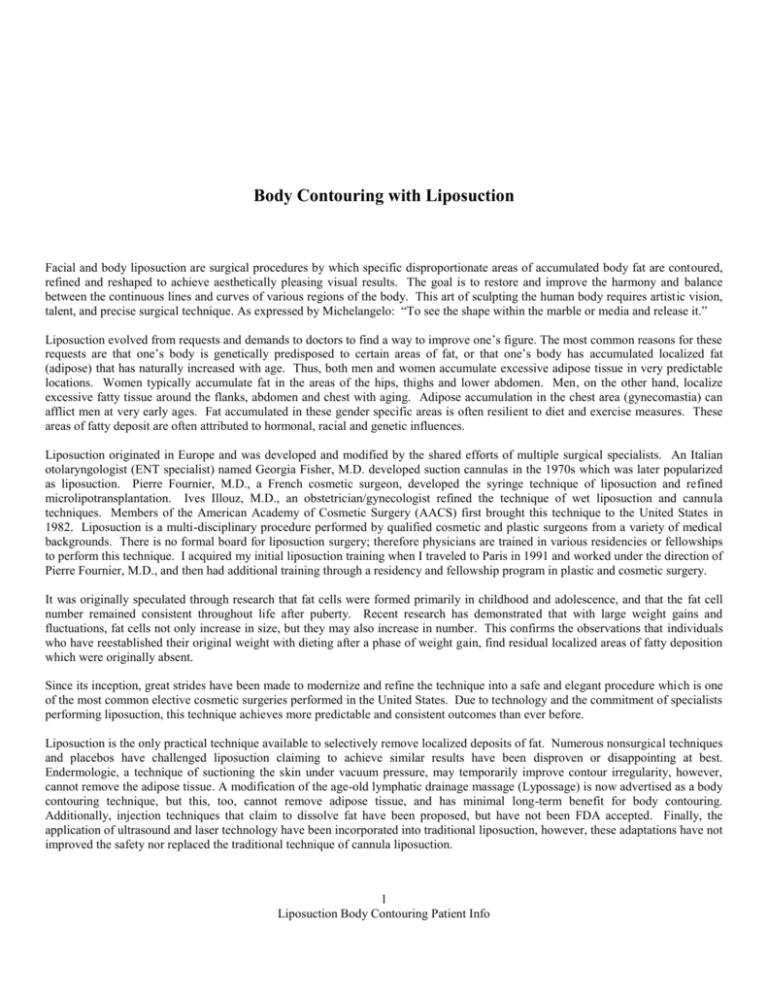
Body Contouring with Liposuction Facial and body liposuction are surgical procedures by which specific disproportionate areas of accumulated body fat are contoured, refined and reshaped to achieve aesthetically pleasing visual results. The goal is to restore and improve the harmony and balance between the continuous lines and curves of various regions of the body. This art of sculpting the human body requires artistic vision, talent, and precise surgical technique. As expressed by Michelangelo: “To see the shape within the marble or media and release it.” Liposuction evolved from requests and demands to doctors to find a way to improve one’s figure. The most common reasons for these requests are that one’s body is genetically predisposed to certain areas of fat, or that one’s body has accumulated localized fat (adipose) that has naturally increased with age. Thus, both men and women accumulate excessive adipose tissue in very predictable locations. Women typically accumulate fat in the areas of the hips, thighs and lower abdomen. Men, on the other hand, localize excessive fatty tissue around the flanks, abdomen and chest with aging. Adipose accumulation in the chest area (gynecomastia) can afflict men at very early ages. Fat accumulated in these gender specific areas is often resilient to diet and exercise measures. These areas of fatty deposit are often attributed to hormonal, racial and genetic influences. Liposuction originated in Europe and was developed and modified by the shared efforts of multiple surgical specialists. An Italian otolaryngologist (ENT specialist) named Georgia Fisher, M.D. developed suction cannulas in the 1970s which was later popularized as liposuction. Pierre Fournier, M.D., a French cosmetic surgeon, developed the syringe technique of liposuction and refined microlipotransplantation. Ives Illouz, M.D., an obstetrician/gynecologist refined the technique of wet liposuction and cannula techniques. Members of the American Academy of Cosmetic Surgery (AACS) first brought this technique to the United States in 1982. Liposuction is a multi-disciplinary procedure performed by qualified cosmetic and plastic surgeons from a variety of medical backgrounds. There is no formal board for liposuction surgery; therefore physicians are trained in various residencies or fellowships to perform this technique. I acquired my initial liposuction training when I traveled to Paris in 1991 and worked under the direction of Pierre Fournier, M.D., and then had additional training through a residency and fellowship program in plastic and cosmetic surgery. It was originally speculated through research that fat cells were formed primarily in childhood and adolescence, and that the fat cell number remained consistent throughout life after puberty. Recent research has demonstrated that with large weight gains and fluctuations, fat cells not only increase in size, but they may also increase in number. This confirms the observations that individuals who have reestablished their original weight with dieting after a phase of weight gain, find residual localized areas of fatty deposition which were originally absent. Since its inception, great strides have been made to modernize and refine the technique into a safe and elegant procedure which is one of the most common elective cosmetic surgeries performed in the United States. Due to technology and the commitment of specialists performing liposuction, this technique achieves more predictable and consistent outcomes than ever before. Liposuction is the only practical technique available to selectively remove localized deposits of fat. Numerous nonsurgical techniques and placebos have challenged liposuction claiming to achieve similar results have been disproven or disappointing at best. Endermologie, a technique of suctioning the skin under vacuum pressure, may temporarily improve contour irregularity, however, cannot remove the adipose tissue. A modification of the age-old lymphatic drainage massage (Lypossage) is now advertised as a body contouring technique, but this, too, cannot remove adipose tissue, and has minimal long-term benefit for body contouring. Additionally, injection techniques that claim to dissolve fat have been proposed, but have not been FDA accepted. Finally, the application of ultrasound and laser technology have been incorporated into traditional liposuction, however, these adaptations have not improved the safety nor replaced the traditional technique of cannula liposuction. 1 Liposuction Body Contouring Patient Info Body Contouring with Liposuction The gold standard technique for liposuction is adipose removal by small microcannulas administered underneath the skin with tumescent anesthesia. The procedure is performed under sterile surgical technique in our office outpatient surgery center under monitored intravenous sedation under the direction of an anesthesia provider. The areas to be treated are infiltrated (or “tumesced”) with a very dilute solution of saline, lidocaine and epinephrine that is injected into the surgical sites. Once the tissue is tumesced and the patient is sufficiently comfortable, adipose is meticulously reduced with microcannulas through small incisions. This technique permits more selective removal and control of aspiration with improved safety and outcome. The goal of liposuction is to improve, contour and sculpt the body by reducing unfavorable areas of localized fat. Liposuction by the microcannula technique removes fat by gentle vacuum suction reducing the reservoir of adipose cells capable of storing fat. Followup results with liposuction patients have documented long lasting results if body weight is maintained at a consistent level. Excessive weight gain after liposuction may result in deposition of fat into new locations and, to a limited extent, in the treated areas. Some reports have documented an increase in breast size in women or enlargement of other body areas with extensive liposuction reduction and postoperative weight gain. Patients often comment that they lose inches with liposuction versus excessive pounds. The appearance after liposuction will be influenced by one’s general state of health, personal stature, skin elasticity, age, weight, hormonal influences and other factors. Each individual patient is unique with respect to response to and the final result of liposuction. SKIN ELASTICITY Inherent skin elasticity and tone often determines the resulting superficial contour after the removal of underlying supportive adipose tissue. Tight elastic skin is universally seen in the very young and is gradually lost as we age. Liposuction being performed at a deeper level beneath the skin does not affect skin quality, thus it is not a technique to correct loose, wrinkled, over-stretched (i.e., stretch marks), or damaged skin. With loss of skin elasticity and aging, liposuction may result in areas of redundant loose or deflated skin after adipose removal. This is a limitation to the end result of liposuction and additional procedures may be required to remove the excessive skin at a later date if so desired. Some patients are best served with surgical excision techniques to address loose skin, musculature, or body structures other than fat as an alternative to liposuction. Since liposuction does not correct structures other than adipose tissue, tummy tuck (abdominoplasty), thigh or arm lift reductions (brachioplasty) may be necessary. CELLULITE Cellulite is a term used to describe dimpling and irregularities that occur on the surface of the skin. It is most frequently seen over the lower torso and thighs in women; it worsens with age and after pregnancy, and becomes more visible as the skin loosens. Cellulite is due to degeneration of the skin, adipose deposits in the skin itself, and from fibrous connective tissue bands that attach to the undersurface of the skin, compartmentalizing the fat. Since liposuction is performed with a smooth cannula and at a specific level beneath the skin, these fibers and adipose pockets are not disrupted by the procedure. Liposuction is not a technique for skin or cellulite correction and does not cure cellulite. In some cases, however, liposuction may soften the appearance of cellulite; however, with poor skin elasticity and severe cases of cellulite, the cellulite appearance may actually become accentuated after the procedure. CONSULTATION Your consultation at our office provides you with private and personal interaction with Dr. Schmid and his staff. Our approach at the Institute of Aesthetic Plastic & Reconstructive Surgery, LLC is to adhere to ethics, standards of care, and interest in your overall health and well being. We integrate a holistic philosophy and approach which requires a commitment to personal health care and lifestyle for all liposuction candidates. Such a proactive attitude to comprehensive and personal health care requires involvement of 2 Liposuction Body Contouring Patient Info Body Contouring with Liposuction lifestyle modifications and practice to obtain long term consistent results. As always, the evaluation at our office respects patient privacy and confidentiality. Liposuction is not a substitute for a healthy diet and exercise. It is not a technique to achieve generalized weight reduction. It provides sculpting of the human body to improve contour and shape to resistant areas of fatty accumulation. It is important for you as a patient to openly express your perceived expectations and motivations from this procedure in that we may obtain an accurate assessment as to whether these expectations are attainable and realistic. Not every patient is a candidate for liposuction. One should realize that there are limitations to what this, or any, surgical technique can achieve and results are individual and variable. Often I will require diet, exercise, and some lifestyle modification in order to achieve favorable body weights prior to liposuction. This is important to establish a healthy pattern for your daily life, reinforce your motivations, and allow your skin to naturally shrink with weight reduction in preparation for this procedure. As previously emphasized this is not a technique for obesity, but is used to refine areas of adiposity which are resilient to diet and exercise measures. Additionally, emotional stability is very important for any cosmetic procedure. After this procedure, the patient experiences recovery symptoms, must abide by activity restrictions, and many will undergo an emotional recovery period or readjustment to his or her new aesthetic image. Consultation allows you to discuss questions or concerns for your clarification and understanding. Preoperative visits are recommended and available to you as a patient to discuss any questions or concerns you may have in order to alleviate anxieties or uncertainties as to your upcoming procedure. A physical examination is necessary to evaluate your overall health, skin quality and tone, body shape and structure, and the proposed areas of concern. Additionally, we will discuss the incisions, anesthesia techniques and pre and postoperative concerns. Preoperative photographs are taken on all patients to provide preoperative planning, and postoperative comparison to follow the progress of your results. All patients are required to obtain a documented medical history and physical examination with a primary care physician and appropriate laboratory tests prior to lipocontouring procedures. Patients taking birth control pills (BCPs) should consider discontinuing this medication one month prior to the surgical procedure, and consider using appropriate alternative prophylactics as directed by your primary care physician or OB/Gyn. Birth control pills are known to increase the risk of blood clot formation in the legs and potential blood embolism. All patients are required to discontinue blood thinners, herbs or anticoagulants prior to this technique to reduce the risk of postoperative bleeding and healing problems. PROCEDURE Liposuction is routinely performed in our office outpatient surgery suite. The length of this surgical procedure depends upon the areas treatment by liposuction and may last between 1-4 hours. Preoperative medication to alleviate your anxiety is available. The procedure is performed with tumescent local anesthesia under IV monitored sedation. The tumescent technique delivers large volumes of diluted local anesthesia to anesthetize the surgical sites. The level of sedation is characterized as “conscious sedation” which provides a moderate level of sedation or anesthesia to the technique. The technique will be performed under a semi-sleep state, however, allows us to communicate with you during your surgery. The injection of the anesthetic solution usually is experienced as a mild burning sensation, which resolves rapidly. Small incisions then are performed at selective sites near the areas from which the fat is to be removed. Small microcannulas are then introduced through the incisions and into the adipose tissues which is removed by a gentle, harmonic, repetitive motion under a vacuum system while the cannula is manipulated beneath the skin. Upon completion of the contouring process, the incisions are closed with temporary sutures. The surgical areas are dressed with tape and an overlying compression garment is applied. This garment will be worn continuously without removal for seven days after surgery until the follow-up visit. This garment is designed for personal hygiene and any early removal of this garment before the designated follow-up removal date may diminish the end result. A support garment is then to be worn for the next five weeks for limited periods of the day. 3 Liposuction Body Contouring Patient Info Body Contouring with Liposuction As part of our patient care program, we offer noninvasive ultrasound therapy postoperatively. This comfortable, non-invasive technique is applied to the skin with a cool ultrasound gel which serves to reduce inflammation, discomfort, and improve the surface results postoperatively. Sequential office visits will be scheduled during the recovery period to have this therapy applied for up to three weeks postoperatively. This is a complimentary service available to all of our liposuction patients upon request. POSTOPERATIVE PERIOD After surgery you will experience some tenderness and discomfort which is controlled well with analgesics. Usually the local anesthetic injected during surgery will be effective up to eight hours postoperatively. For the first week following surgery, the treated areas while develop various degrees of swelling. At first you may appear slightly larger than you did before surgery, the garments may feel tighter, and you may even experience some initial weight gain. These changes are attributed to the swelling from fluid retention. By the end of the first week, however, the swelling associated with surgery begins to subside, and into the second week you will notice diminution of the swelling with appreciable contour improvement in the treated areas. As time passes the swelling will resolve, and your final improvement may not be apparent until three months after surgery due to the healing process. If the calves and ankles have been treated, the swelling will be prolonged and the final improvement may take up to 6-12 months. All patients should expect bruising postoperatively which may last up to three or more weeks. Bruising and swelling may accumulate into the more dependent body areas. Fatigue, soreness and a certain amount of numbness or reduced sensation in the treated areas is also to be expected. It is rare to have permanent numbness from this procedure. One can expect mild bloody oozing from the incisional sites for a few days after the procedure. For this reason, we advise wearing accommodatingly loose clothing. COMPLICATIONS AND UNTOWARD RESULTS Due to the popularity and demand for liposuction surgery, numerous academies have undertaken safety studies. Arthur Andersen conducted a survey with the American Academy of Cosmetic Surgery finding that liposuction, when performed by qualified and skilled physicians, is a clinically safe surgical procedure as detailed by the low complication rate of less than 1 in 1000 (from total cases studied in the years 1995-1997; 1.2%). It is due to the advanced technique of tumescent liposuction and the avoidance of general anesthesia which has improved the overall safety outcomes of this procedure. As with any surgical procedure, liposuction carries the risk of complications even when the surgeon uses the utmost care, judgment and skill. Severe risks are rare with liposuction, and the technique has been shown to be extremely safe. Since response to liposuction is individual, no guarantees are expressed or implied as to the results or outcomes of this surgery. Patients may experience contour irregularities in the treated areas following liposuction. Frequently, irregularities are temporary, but for some patients they may be permanent. Additional irregularities such as lumpiness, dimples, depressions, and uneven contour can occur. It should be understood that perfect symmetry of the human body is genetically uncommon. In liposuction surgery, symmetry is a goal, although side-to-side differences can result. Rarely, a small percentage of patients may require a secondary surgery or “touchup” procedure six to nine months after the initial procedure most frequently for the removal of additional fat, requiring additional expense. Areas of overreduction may result in dimpling and depressions which would require a refilling technique called lipotransfer or fat transplantation. Risks such as bleeding, seromas (accumulation of serum fluid), infection or sepsis, thrombophlebitis (inflammation of the veins of the legs), and excessive incisional scar formation are possible with any surgery. There can also be adverse reactions to medications used during surgery or the recovery period, reactions to skin markers, or sensitivity to tape, latex and postoperative dressings. Rarely, toxicity or shock and the requirement of blood transfusions during or after surgery may be required. 4 Liposuction Body Contouring Patient Info Body Contouring with Liposuction Unfortunately, the media has publicized – even sensationalized – the adverse consequences following liposuction surgery. Pulmonary or fat embolization (small particles of fat traveling to the lungs through the blood system or other parts of the body), respiratory and cardiac failure incidents have received particularly lurid coverage. Fortunately, these complications are rare (1 in 50,000), and most patients who have had disastrous consequences following liposuction were high risk patients or underwent exhaustive combined procedures (i.e., extensive liposuction with a tummy tuck procedure). At our office we strictly adhere to the safety standard guidelines reinforced by national and state recommendations. Understand that there are limitations to liposuction and that it is a not a treatment for the skin or other structures. There are surgical limitations as to the amount of fat which can be safely removed within one setting, and the amount of local anesthesia that can be safely administered without reaching toxic drug levels. At times, liposuction may require serial or staged techniques in order to address extensive areas of adiposity. Liposuction actually compares favorably to other cosmetic procedures with respect to risks. The vast majority of patients are immensely satisfied with the results. Should any of the aforementioned information be unclear to you or require additional counseling prior to surgery, please discuss these concerns with my staff or me. If you decide to undertake this procedure or would like to express that throughout your recovery period, my staff and I will make every attempt to be available to address any of your personal needs, and offer a commitment of support through your postoperative period to ensure an expedient and comfortable recovery. Please acknowledge your review and understanding of the aforementioned information by providing a signature below. ___________________________________ Patient ____________________ Date ___________________________________ Witness ____________________ Date ___________________________________ Peter M. Schmid, D.O. ____________________ Date Liposuction Body Contouring Patient Info 5 Liposuction Body Contouring Patient Info
